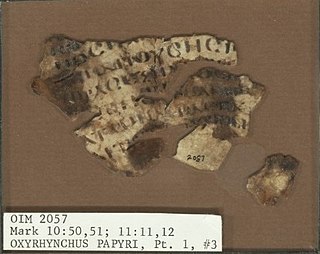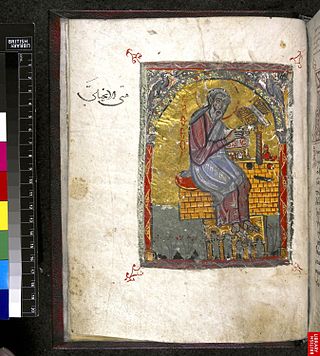Related Research Articles

Codex Campianus is designated as "M" or "021" in the Gregory-Aland cataloging system and as "ε 72" in the Von Soden system. It is a Greek uncial manuscript of the New Testament, dated palaeographically to the 9th century. The manuscript has complex contents. It has marginalia and was prepared for liturgical (religious) use.

Codex Monacensis, designated by X or 033 (in the Gregory-Aland numbering of New Testament manuscripts), A3 (in the von Soden numbering of New Testament manuscripts), is a Greek uncial manuscript of the four Gospels written on parchment. The manuscript contains commentary from several church fathers. Using the study of comparative writing styles (palaeography), it has been dated to the 9th or 10th century. The manuscript has several gaps, and has been rebound at least once.
Uncial 056 (in the Gregory-Aland numbering), O7 (von Soden), is a Greek uncial manuscript of the New Testament, dated paleographically to the 10th century.

Uncial 069, ε 12 (Soden), is a Greek uncial manuscript of the New Testament, dated paleographically to the 5th century.
Uncial 083, ε 31 (Soden), is a Greek uncial manuscript of the New Testament, dated paleographically to the 6th/7th century. The codex now is located at the Russian National Library in Saint Petersburg.
Uncial 085, ε 23 (Soden), is a Greek uncial manuscript of the New Testament, dated palaeographically to the 6th century.
Uncial 0102, ε 42 (Soden), is a Greek uncial manuscript of the New Testament. It is dated paleographically to the 7th century.

Uncial 0115, ε 57 (Soden); is a Greek uncial manuscript of the New Testament, dated paleographically to the 9th or 10th-century. Formerly it was labelled by Wa.
Uncial 0141, CL13 (Soden), is a Greek uncial manuscript of the New Testament, dated palaeographically to the 10th century.

Uncial 0187, ε 024 (Soden), is a Greek uncial manuscript of the New Testament, dated paleographically to the 6th century.
Uncial 0211, ε 051 (Soden), is a Greek uncial manuscript of the New Testament, dated paleographically to the 7th century.
Minuscule 34 (in the Gregory-Aland numbering), A19 (Von Soden). It is a Greek minuscule manuscript of the New Testament, written on vellum. Palaeographically it has been assigned to the 10th century.
Minuscule 39 (in the Gregory-Aland numbering), A140 (Von Soden), is a Greek minuscule manuscript of the New Testament, written on vellum. Palaeographically it has been assigned to the 11th century. It has complex contents and some marginalia.

Minuscule 72, ε 110, is a Greek minuscule manuscript of the New Testament, on parchment leaves. Palaeographically it has been assigned to the 11th century. John Mill called it Codex Ephesinus. The manuscript has complex contents with full marginalia.
Minuscule 138 (in the Gregory-Aland numbering), A304 (Soden), is a Greek minuscule manuscript of the New Testament, on parchment leaves. Palaeographically it has been assigned to the 11th century. The manuscript is lacunose.
Minuscule 197 (in the Gregory-Aland numbering), A132 (Soden), is a Greek minuscule manuscript of the New Testament, on parchment. Palaeographically it has been assigned to the 11th century. The manuscript is lacunose. It has marginalia.
Minuscule 287, ε 523 (Soden), is a Greek minuscule manuscript of the New Testament, on paper. It is dated by a colophon to the year 1478. It has marginalia.
Lectionary 1599 (Gregory-Aland), designated by siglum ℓ1599 is a Greek manuscript of the New Testament, on parchment. Palaeographically it has been assigned to the 10th or 11th century. The manuscript is lacunose. It is known as Argos Lectionary.
Lectionary 300, designated by siglum ℓ300 is a Greek manuscript of the New Testament, written on parchment. It has been palaeographically assigned to the 11th century. The manuscript is written in gold ink and contains Gospel lessons for selected days. It was named as "Gospel of Theodosius".
Minuscule 994 (in the Gregory-Aland numbering), A227 Cι33 (von Soden), is a 10th or 11th-century Greek minuscule manuscript of the New Testament on parchment. The manuscript has not survived in complete condition. It has some marginalia.
References
- 1 2 3 4 Aland, Kurt; Aland, Barbara (1995). The Text of the New Testament: An Introduction to the Critical Editions and to the Theory and Practice of Modern Textual Criticism . Erroll F. Rhodes (trans.). Grand Rapids: William B. Eerdmans Publishing Company. p. 119. ISBN 978-0-8028-4098-1.
- 1 2 3 Gregory, Caspar René (1900). Textkritik des Neuen Testaments. Vol. 1. Leipzig: Hinrichs. p. 178.
- ↑ "Liste Handschriften". Münster: Institute for New Testament Textual Research. Retrieved 21 April 2011.
- ↑ J. Burgon, The last Twelve Verses of Mark (London, 1871), pp. 282-287.
- ↑ Jean-Pierre-Paul Martin, Description technique des manuscrits grecs relatifs au N. T., conservés dans les bibliothèques des Paris (Paris 1883), p. 81.